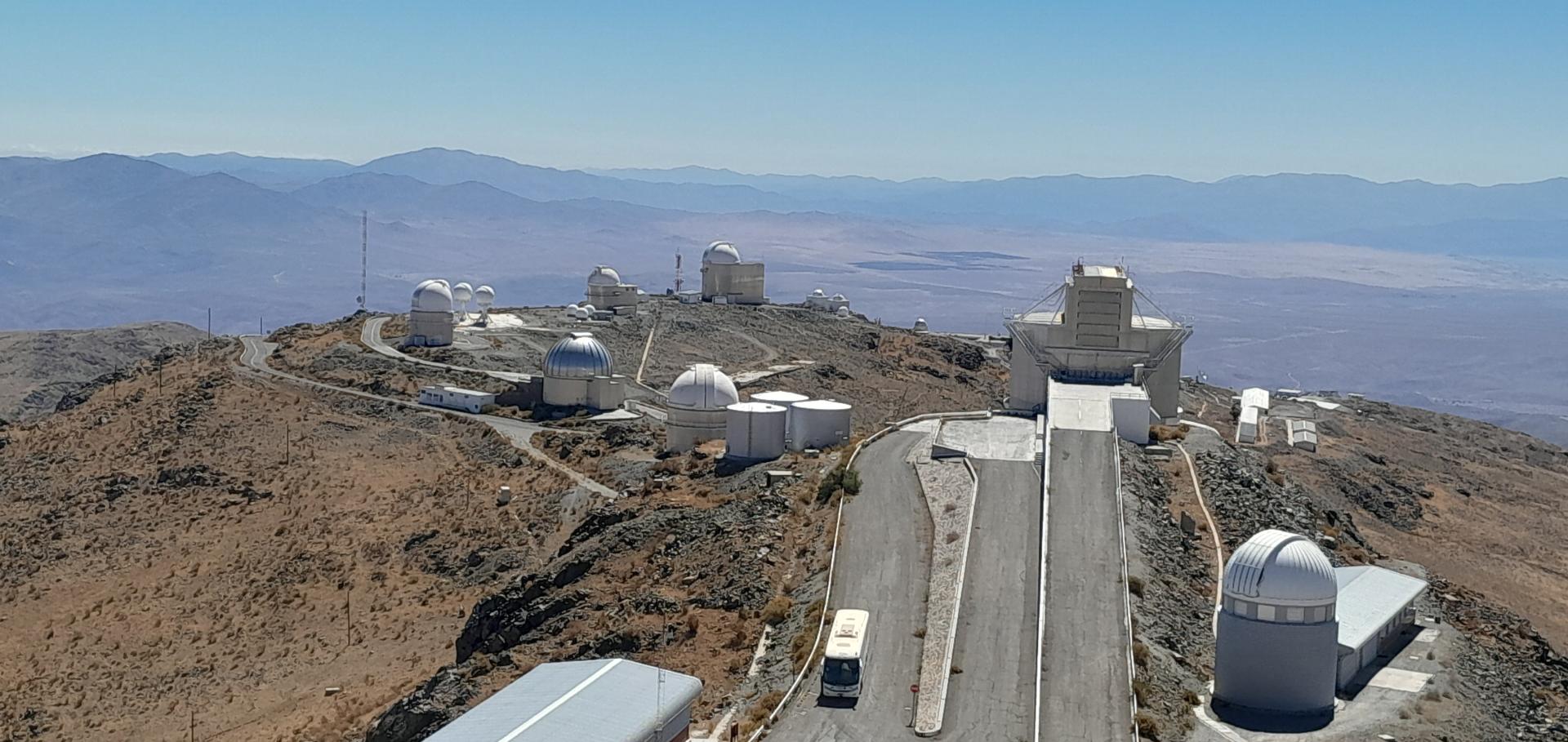Optical and near-infrared stellar activity characterization of the early M dwarf Gl 205 with SOPHIE and SPIRou
Astronomy & Astrophysics, Volume 673, id.A14, 40 pp.
Abstract:
Context. The stellar activity of M dwarfs is the main limiting factor in the discovery and characterization of the exoplanets orbiting them, because it induces quasi-periodic radial velocity (RV) variations.
Aims: We aim to characterize the magnetic field and stellar activity of the early, moderately active M dwarf Gl 205 in the optical and near-infrared (NIR) domains.
Methods: We obtained high-precision quasi-simultaneous spectra in the optical and NIR with the SOPHIE spectrograph and SPIRou spectropolarimeter between 2019 and 2022. We computed the RVs from both instruments and the SPIRou Stokes V profiles. We used Zeeman-Doppler imaging (ZDI) to map the large-scale magnetic field over the time span of the observations. We studied the temporal behavior of optical and NIR RVs and activity indicators with the Lomb-Scargle periodogram and a quasi-periodic Gaussian process regression (GPR). In the NIR, we studied the equivalent width of Al I, Ti I, K I, Fe I, and He I. We modeled the activity-induced RV jitter using a multi-dimensional GPR with activity indicators as ancillary time series.
Results: The optical and NIR RVs show similar scatter but NIR shows a more complex temporal evolution. We observe an evolution of the magnetic field topology from a poloidal dipolar field in 2019 to a dominantly toroidal field in 2022. We measured a stellar rotation period of Prot = 34.4 ± 0.5 days in the longitudinal magnetic field. Using ZDI, we measure the amount of latitudinal differential rotation (DR) shearing the stellar surface, yielding rotation periods of Peq = 32.0 ± 1.8 days at the stellar equator and Ppol = 45.5 ± 0.3 days at the poles. We observed inconsistencies in the periodicities of the activity indicators that could be explained by these DR values. The multi-dimensional GP modeling yields an RMS of the RV residuals down to the noise level of 3 m s−1 for both instruments while using Hα and the BIS in the optical and the full width at half maximum (FWHM) in the NIR as ancillary time series.
Conclusions: The RV variations observed in Gl 205 are due to stellar activity, with a complex evolution and different expressions in the optical and NIR revealed thanks to an extensive follow-up. Spectropolarimetry remains the best technique to constrain the stellar rotation period over standard activity indicators, particularly for moderately active M dwarfs.
Aims: We aim to characterize the magnetic field and stellar activity of the early, moderately active M dwarf Gl 205 in the optical and near-infrared (NIR) domains.
Methods: We obtained high-precision quasi-simultaneous spectra in the optical and NIR with the SOPHIE spectrograph and SPIRou spectropolarimeter between 2019 and 2022. We computed the RVs from both instruments and the SPIRou Stokes V profiles. We used Zeeman-Doppler imaging (ZDI) to map the large-scale magnetic field over the time span of the observations. We studied the temporal behavior of optical and NIR RVs and activity indicators with the Lomb-Scargle periodogram and a quasi-periodic Gaussian process regression (GPR). In the NIR, we studied the equivalent width of Al I, Ti I, K I, Fe I, and He I. We modeled the activity-induced RV jitter using a multi-dimensional GPR with activity indicators as ancillary time series.
Results: The optical and NIR RVs show similar scatter but NIR shows a more complex temporal evolution. We observe an evolution of the magnetic field topology from a poloidal dipolar field in 2019 to a dominantly toroidal field in 2022. We measured a stellar rotation period of Prot = 34.4 ± 0.5 days in the longitudinal magnetic field. Using ZDI, we measure the amount of latitudinal differential rotation (DR) shearing the stellar surface, yielding rotation periods of Peq = 32.0 ± 1.8 days at the stellar equator and Ppol = 45.5 ± 0.3 days at the poles. We observed inconsistencies in the periodicities of the activity indicators that could be explained by these DR values. The multi-dimensional GP modeling yields an RMS of the RV residuals down to the noise level of 3 m s−1 for both instruments while using Hα and the BIS in the optical and the full width at half maximum (FWHM) in the NIR as ancillary time series.
Conclusions: The RV variations observed in Gl 205 are due to stellar activity, with a complex evolution and different expressions in the optical and NIR revealed thanks to an extensive follow-up. Spectropolarimetry remains the best technique to constrain the stellar rotation period over standard activity indicators, particularly for moderately active M dwarfs.
One year of AU Mic with HARPS - II. Stellar activity and star-planet interaction
Monthly Notices of the Royal Astronomical Society Oxford University Press 512:4 (2022) 5067-5084
Abstract:
We present a spectroscopic analysis of a 1-yr intensive monitoring campaign of the 22-Myr old planet-hosting M dwarf AU Mic using the HARPS spectrograph. In a companion paper, we reported detections of the planet radial velocity (RV) signatures of the two close-in transiting planets of the system, with respective semi-amplitudes of 5.8 ± 2.5 and 8.5 ± 2.5 m s-1 for AU Mic b and AU Mic c. Here, we perform an independent measurement of the RV semi-amplitude of AU Mic c using Doppler imaging to simultaneously model the activity-induced distortions and the planet-induced shifts in the line profiles. The resulting semi-amplitude of 13.3 ± 4.1 m s-1 for AU Mic c reinforces the idea that the planet features a surprisingly large inner density, in tension with current standard models of core accretion. Our brightness maps feature significantly higher spot coverage and lower level of differential rotation than the brightness maps obtained in late 2019 with the SPIRou spectropolarimeter, suggesting that the stellar magnetic activity has evolved dramatically over a ∼1-yr time span. Additionally, we report a 3σ detection of a modulation at 8.33 ± 0.04 d of the He i D3 (5875.62 Å) emission flux, close to the 8.46-d orbital period of AU Mic b. The power of this emission (a few 1017 W) is consistent with 3D magnetohydrodynamical simulations of the interaction between stellar wind and the close-in planet if the latter hosts a magnetic field of ∼10 G. Spectropolarimetric observations of the star are needed to firmly elucidate the origin of the observed chromospheric variability.The EXPRES Stellar Signals Project II. State of the field in disentangling photospheric velocities
Astronomical Journal American Astronomical Society 163:4 (2022) 171
Abstract:
Measured spectral shifts due to intrinsic stellar variability (e.g., pulsations, granulation) and activity (e.g., spots, plages) are the largest source of error for extreme-precision radial-velocity (EPRV) exoplanet detection. Several methods are designed to disentangle stellar signals from true center-of-mass shifts due to planets. The Extreme-precision Spectrograph (EXPRES) Stellar Signals Project (ESSP) presents a self-consistent comparison of 22 different methods tested on the same extreme-precision spectroscopic data from EXPRES. Methods derived new activity indicators, constructed models for mapping an indicator to the needed radial-velocity (RV) correction, or separated out shape- and shift-driven RV components. Since no ground truth is known when using real data, relative method performance is assessed using the total and nightly scatter of returned RVs and agreement between the results of different methods. Nearly all submitted methods return a lower RV rms than classic linear decorrelation, but no method is yet consistently reducing the RV rms to sub-meter-per-second levels. There is a concerning lack of agreement between the RVs returned by different methods. These results suggest that continued progress in this field necessitates increased interpretability of methods, high-cadence data to capture stellar signals at all timescales, and continued tests like the ESSP using consistent data sets with more advanced metrics for method performance. Future comparisons should make use of various well-characterized data sets—such as solar data or data with known injected planetary and/or stellar signals—to better understand method performance and whether planetary signals are preserved.One year of AU Mic with HARPS: I-measuring the masses of the two transiting planets
Monthly Notices of the Royal Astronomical Society Oxford University Press 512:2 (2022) 3060-3078
Abstract:
The system of two transiting Neptune-sized planets around the bright, young M-dwarf AU Mic provides a unique opportunity to test models of planet formation, early evolution, and star-planet interaction. However, the intense magnetic activity of the host star makes measuring the masses of the planets via the radial velocity (RV) method very challenging. We report on a 1-yr, intensive monitoring campaign of the system using 91 observations with the HARPS spectrograph, allowing for detailed modelling of the ∼600 m s-1 peak-to-peak activity-induced RV variations. We used a multidimensional Gaussian Process framework to model these and the planetary signals simultaneously. We detect the latter with semiamplitudes of Kb = 5.8 ± 2.5 m s-1 and Kc = 8.5 ± 2.5 m s-1, respectively. The resulting mass estimates, Mb = 11.7 ± 5.0 M⊕ and Mc = 22.2 ± 6.7 M⊕, suggest that planet b might be less dense, and planet c considerably denser than previously thought. These results are in tension with the current standard models of core-accretion. They suggest that both planets accreted a H/He envelope that is smaller than expected, and the trend between the two planets' envelope fractions is the opposite of what is predicted by theory.
Magnetic field evolution of the K2 dwarf V471 Tau
Monthly notices of the Royal Astronomical Society, 513, 2893
Abstract:
Observations of the eclipsing binary system V471 Tau show that the time of the primary eclipses varies in an apparent periodic way. With growing evidence that the magnetically active K2 dwarf component might be responsible for driving the eclipse timing variations (ETVs), it is necessary to monitor the star throughout the predicted ~35 yr activity cycle that putatively fuels the observed ETVs. We contribute to this goal with this paper by analysing spectropolarimetric data obtained with ESPaDOnS at the Canada-France-Hawaii Telescope in 2014 December and 2015 January. Using Zeeman-Doppler Imaging, we reconstruct the distribution of brightness inhomogeneities and large-scale magnetic field at the surface of the K2 dwarf. Compared to previous tomographic reconstructions of the star carried out with the same code, we probe a new phase of the ETVs cycle, offering new constraints for future works exploring whether a magnetic mechanism operating in the K2 dwarf star is indeed able to induce the observed ETVs of V471 Tau.


